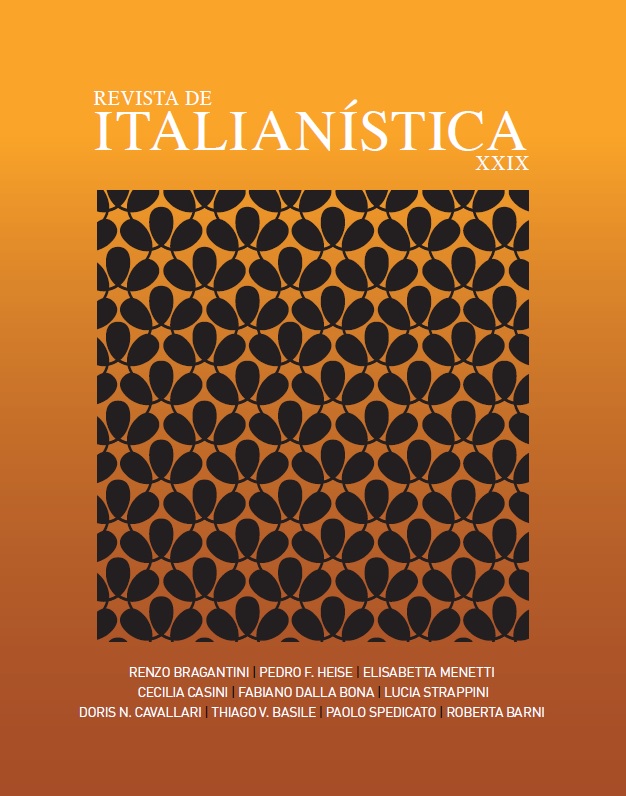Hoc Est Corpus Meum: LeNarrative Medioevali del Couer Mangé e la Novella del Decameron IV, 9
DOI:
https://doi.org/10.11606/issn.2238-8281.v0i29p149-167Keywords:
Decameron, cœur mangé, Middle Ages, Eucharist, anthropophagy, Cœur mangé, Middle agesAbstract
The story of a woman induced by a cruel marital revenge to unknowingly eat her lover’s heart is an extremely productive topos in Western Literature. The theme of the cœur mangé, already widespread in the folklore and firmly established in archaic religious and anthropological beliefs, attains in the Middle Ages its most significant representations. To eat the enemies’ heart is a ritual in which the living indubitably vanquishes the dead and exorcizes an eventual vengeance. From the myth of Dionysius to Decameron’s IV, 9, an analysis about the topos of the eaten hearts is offered, without leaving behind the anthropological, cultural and religious aspectsDownloads
References
ALIGHIERI, D. La vita nuova e le Rime. Bologna: Zanichelli, 1964.
ALVES, R. Lições de feitiçaria. São Paulo: Loyola, 2000.
BENOZZO, F. Etnofilia del cuore: una piccola storia dal paleolitico a oggi. In CARAFFI, P. (org.). Corpo e cuore. Bologna: Emil de Odoya, 2012. p. 125-144.
BOCCACCIO, G. Decameron. 2 v. Milano: Mondadori, 2002.
BRANCA, V. Note. In BOCCACCIO, G. Decameron. v. 2. Milano: Mondadori, 2002.
CAMPORESI, P. La casa dell’eternità. Milano: Garzanti, 1987.
CITATI, P. Eucaristia, il doppio scandalo al cuore del cristianesimo. Corriere della Sera, Milano, Cultura, p. 23, 23 luglio 2013.
DI MAIO, M. Le cœur mangé: histoire d’un thème littéraire du moyen âge au XIXe. Siècle. Trad. Anne Bouffand. Paris: Presses de l’Université Paris-Sorbonne, 2005.
JAKEMES. Il Romanzo del Castellano de Coucy e della Dama di Fayel. Trad. Anna Maria Babbi. Torino: Nuova Pratiche, 1994.
JUNG, C. G. Psicologia e religione. Trad. Bovero Caporali. Torino: Bollati Boringhier, 2000.LE GOFF, J. Il corpo nel medioevo. Trad. Fausta Cataldi Villari. Roma; Bari: Laterza, 2005.
LESTRINGANT, F. O canibal: grandeza e decadência. Trad. Mary Lucy Murray Del Priore. Brasília: UnB, 1997.
MATZKE, J. E. The legend of the eaten heart. Modern Language Works, Baltimore, v. XXVI, nº 1, jan. 1911.
ROUGEMONT, D. de. El amor y Occidente. Trad. Antoni Vicens. 9 ed. Barcelona: Kairós, 2006.
RYKWERT, J. La colonna danzante: sull’ordine in architettura. Milano: Scheiwiller, 2010.
SANGUINETI, F. Quarta giornata. Heliotropia, 4, 1-2, p. 1-19, 2007. Disponível em <http://www.heliotropia.org/04-0102/sanguineti.pdf>. Ultimo accesso: 23 ott. 2013.SCOTTO, R. Il fuoco e i falò: la sessualità e l’eucaristia. Roma: Città Nuova, 2009.
TERRUSI, L. Ancora sul “cuore mangiato”: riflessioni su Decameron IV 9, con una postilla doniana. La parola del testo. Pisa: Fabrizio Serra, nº1, anno II, p. 49-62, 1998.
VISSER, M. O ritual do jantar. Rio de Janeiro: Campus, 1998.
Downloads
Published
Issue
Section
License
Copyright (c) 2015 Revista de Italianística

This work is licensed under a Creative Commons Attribution-NonCommercial-NoDerivatives 4.0 International License.
A revista retém os direitos patrimoniais dos artigos e os publica simultâneamente sob uma Licença Creative Commons-Atribuição-Não Comercial-Sem Derivações.



